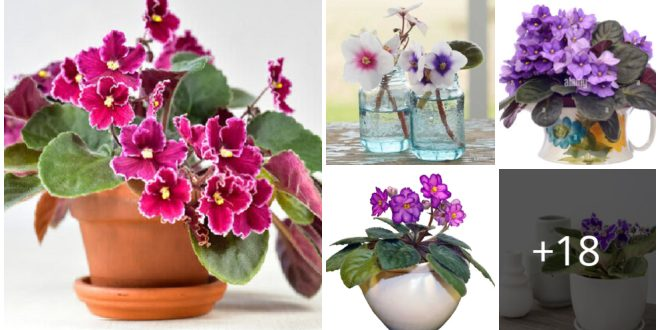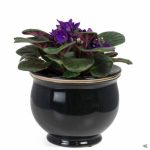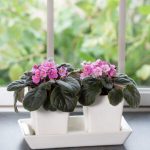
African violets are small houseplants that grow quite well in normal house temperatures, flowering almost continuously in clusters of white, blue, or purple flowers over fuzzy leaves. Here’s how to care for African violets in your home.
About African Violets
Despite their common name, African violets are not a type of violet, but they do produce vivid, violet-colored flowers. They are now categorized in the genus Streptocarpus. However, as their name suggests, African violets are native to East Africa, stemming from the tropical rainforests of Tanzania and Kenya. In 1892, German colonial officer Walter von Saint Paul-Illaire identified these plants and sent seeds back to Germany. Read more about these dainty plants here.
African violets do best and produce the most blooms in bright, indirect light with regular house temperatures (no lower than 55F at night nor above 75F during the day). Though they are generally easy to care for, they can go through fussy spells. Don’t be discouraged!












How to Plant African Violets
- You can use an actual African violet potting mix or an all-purpose potting soil, as long as it is well-draining. Here’s how to create your own mix.
- Keep African violets planted in small pots and repot every few years to mix in fresh soil. Being a bit pot-bound encourages African violets to bloom more, so don’t be too quick to give them more space.
- The soil should be loose and well-drained, and high organic matter content is a plus. Learn about organic soil amendments.
- When repotting African violets, don’t plant them any deeper than they were already planted and be careful not to bury the crown of the plant. African violets’ stems can be susceptible to rot if kept too moist.
How to Care for African Violets
Watering
- Keep the soil lightly moist, but be careful not to overwater, as African violets’ soft stems are very susceptible to rot.
- Use room-temperature water, as chilled water can leave marks on the leaves.
- Leaves are susceptible to rot and fungal spots if kept in high humidity, so water African violets from the bottom to avoid getting excess water on the foliage.
Lighting
- African violets prefer bright, indirect light. Avoid direct sunlight and keep them at least a few feet away from bright south- or west-facing windows. An east- or north-facing window gives them the best lighting without the risk of burning their sensitive foliage.
- Artificial lighting works well, too. Use fluorescent or LED bulbs to supplement natural lighting.
- Thin, dark green leaves and leggy stems tell you that the plant is getting too little light; light green or bleached leaves indicate too much light.
Fertilizing
- During the active growing season (spring and summer), fertilize every 2 weeks with a high phosphorous plant food. Only start to fertilize when the plant appears to need an extra boost (slow, thin growth; pale or yellowing leaves).
- Over-fertilizing is a more common problem than under-fertilizing, since most soil mixes come infused with plenty of nutrients.
General Care
- Many varieties prefer warm conditions (65°F/18°C or warmer) though some are more tolerant of cooler conditions. In any case, keep them away from drafty windows in winter.
- Plants should be shifted to larger pots as they grow, but keeping African violets slightly root-bound can encourage them to bloom. One sign that your violet needs repotting is wilted leaves.
- The fuzzy leaves have a tendency to collect dust and dirt. Brush them off gently with a small, soft-bristled paintbrush.
- Blooming issues? Check out our tips on how to make sure your African violets flower.
RECOMMENDED VARIETIES
There are hundreds of varieties and hybrids, from miniature violets to trailing varieties! They differ mainly in the colors of their flowers, which range from white to purple, though some varieties have variegation in their foliage and flowers as well.
African violets are typically classified by size, based on how wide they grow:
- Miniature: less than 8 inches across
- Standard: 8–16 inches across
- Large: more than 16 inches across
WIT AND WISDOM
- Violets (Viola)—though unrelated to African violets—are one of the February birth flowers, so a potted African violet can make a bright gift for a February birthday.
- The violet symbolizes loyalty, devotion, and faithfulness. Find out more flower symboism here.